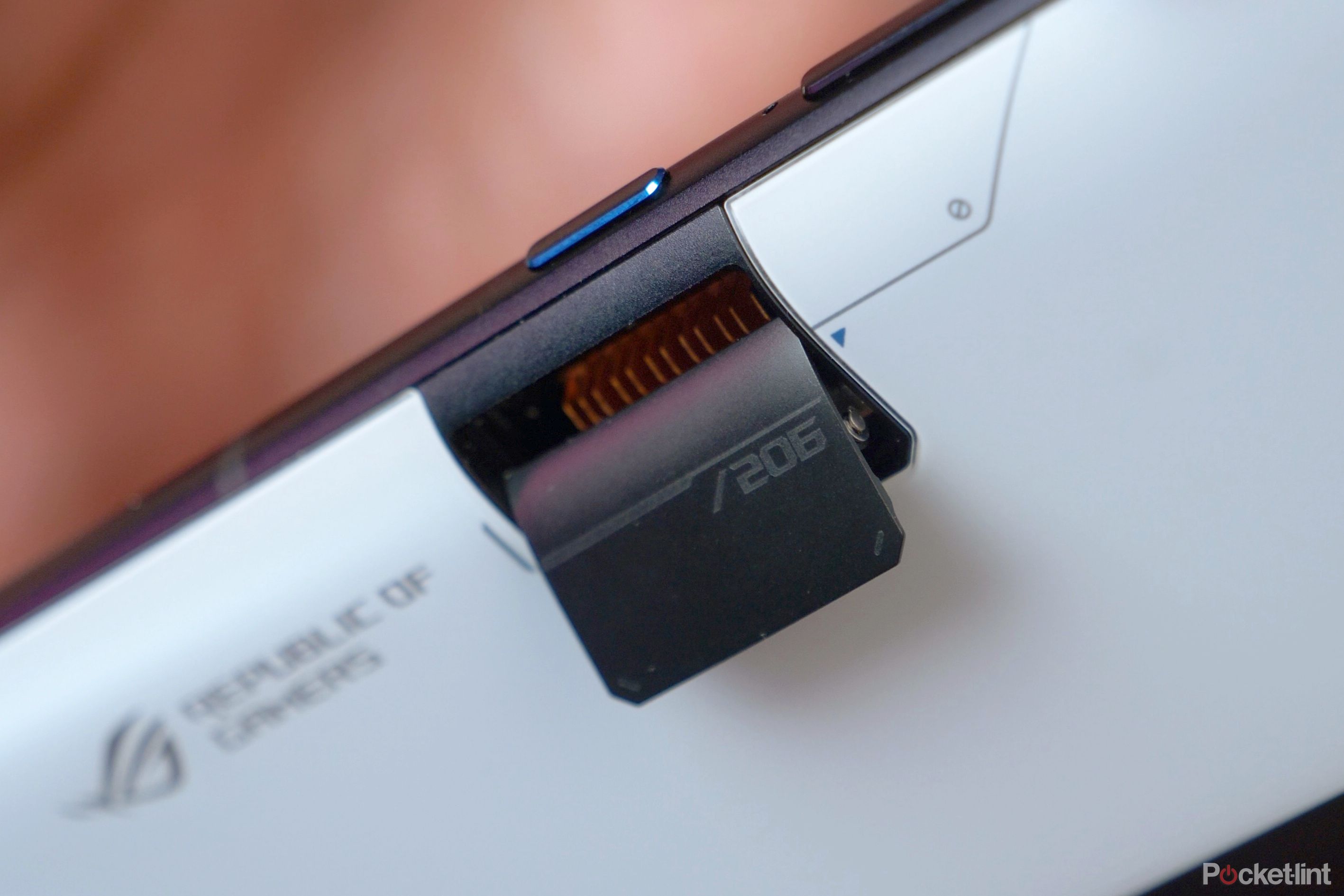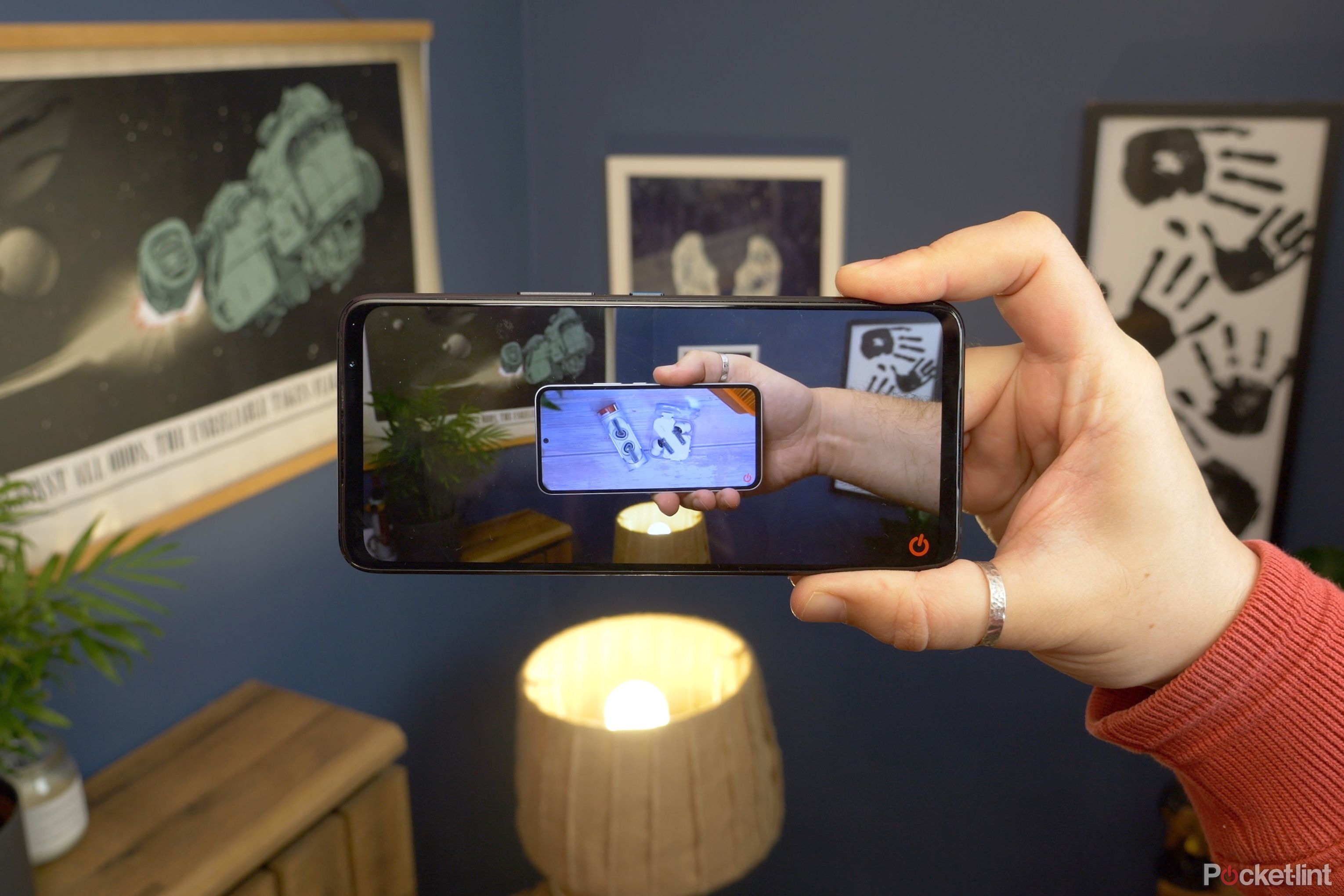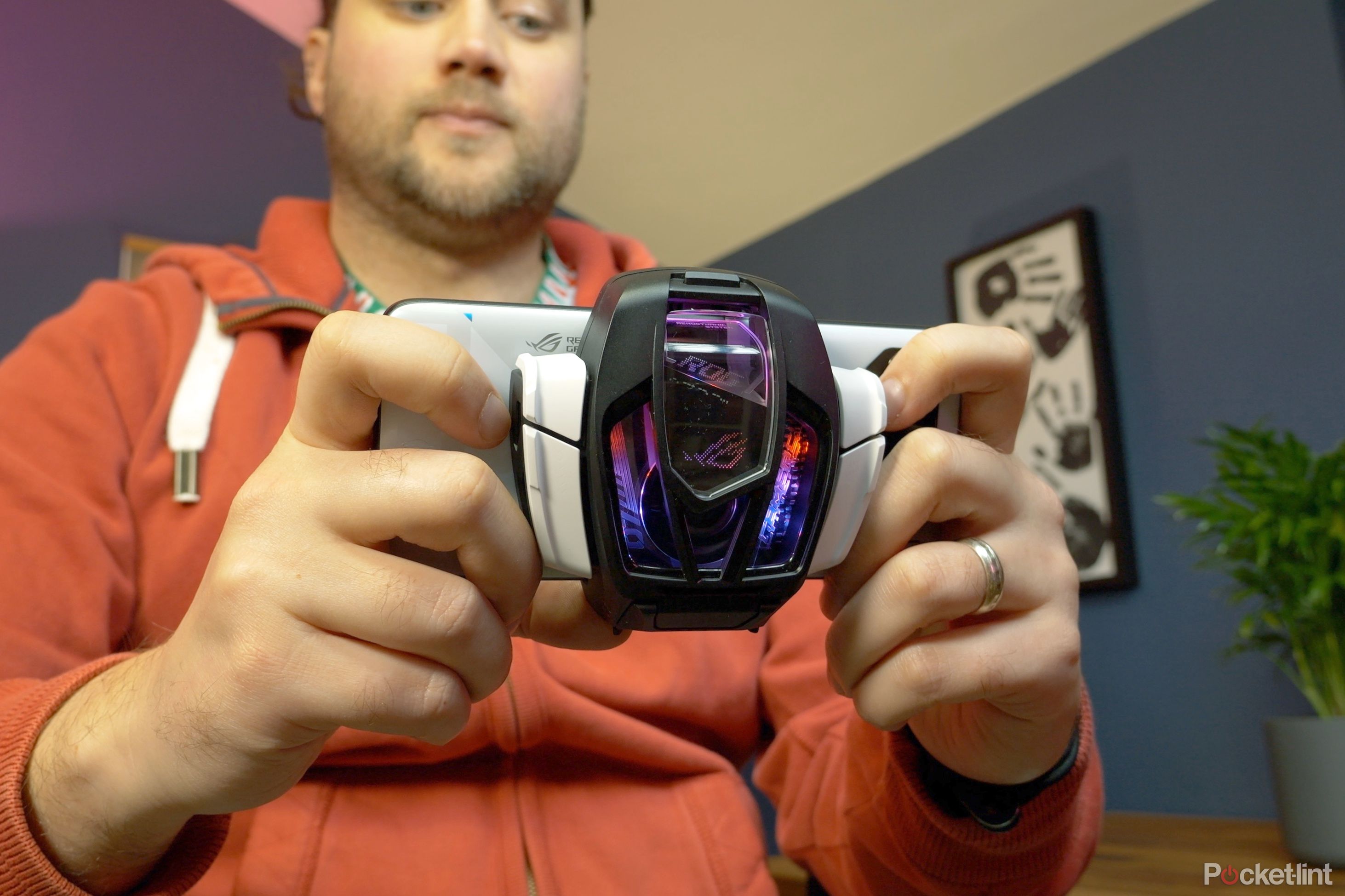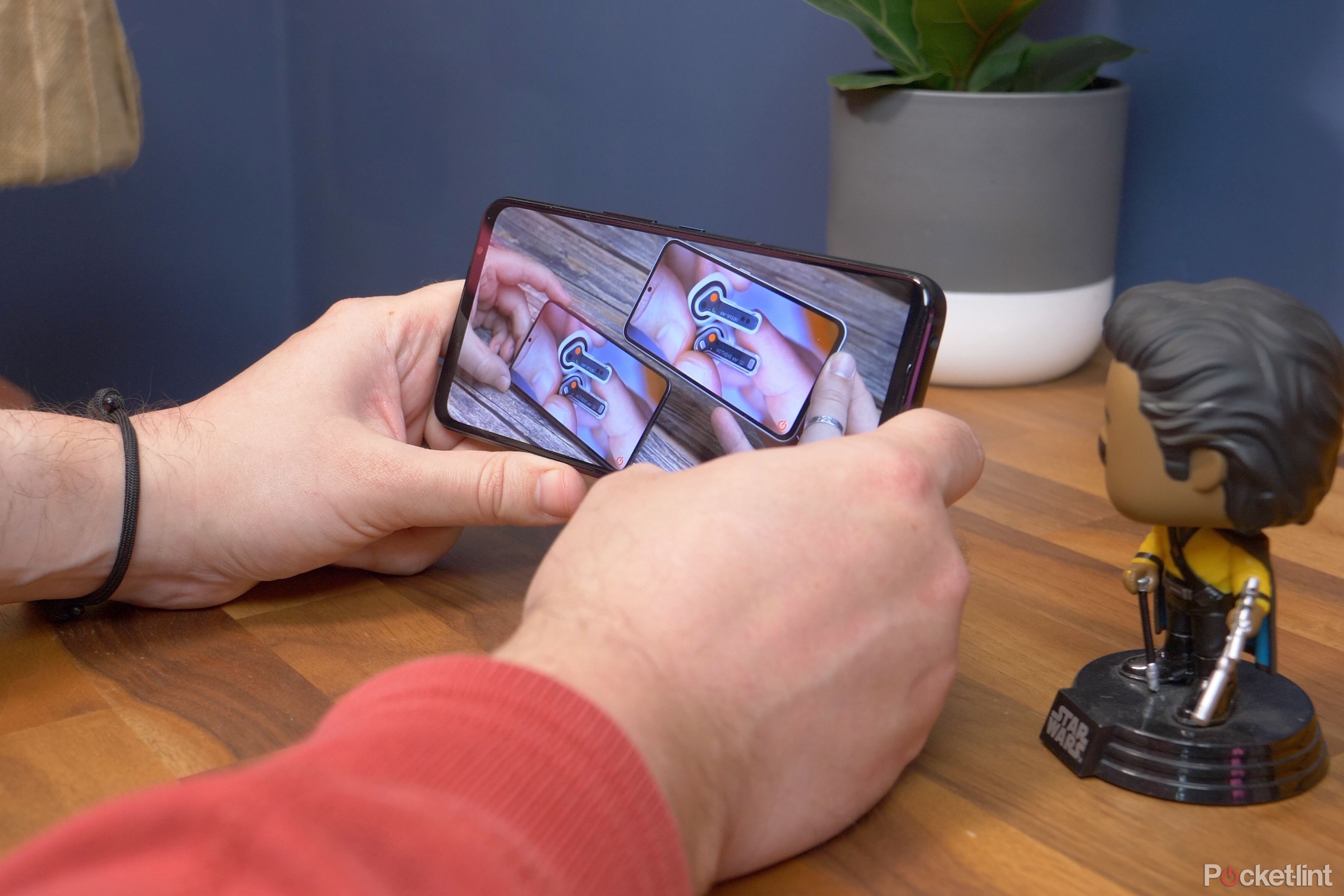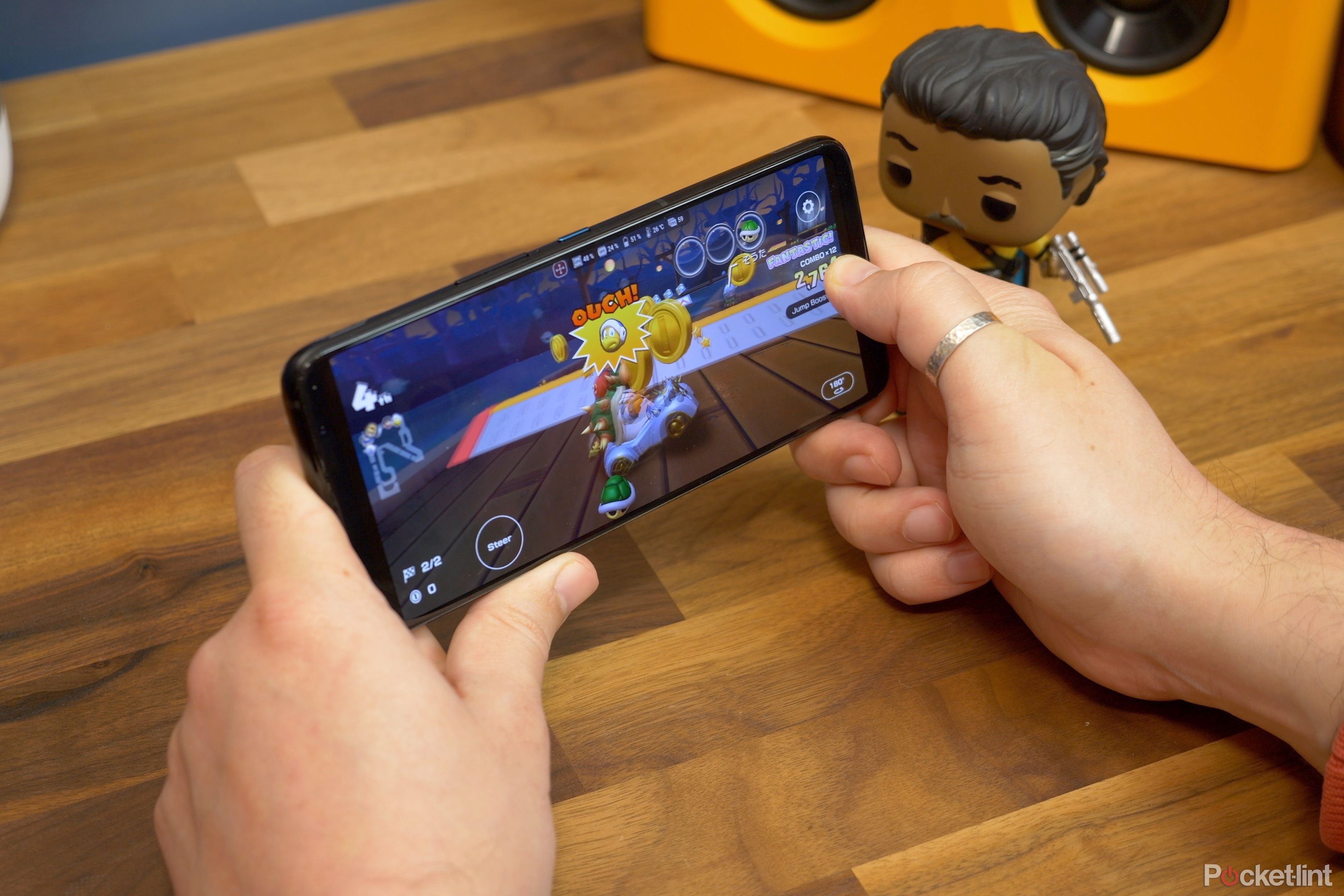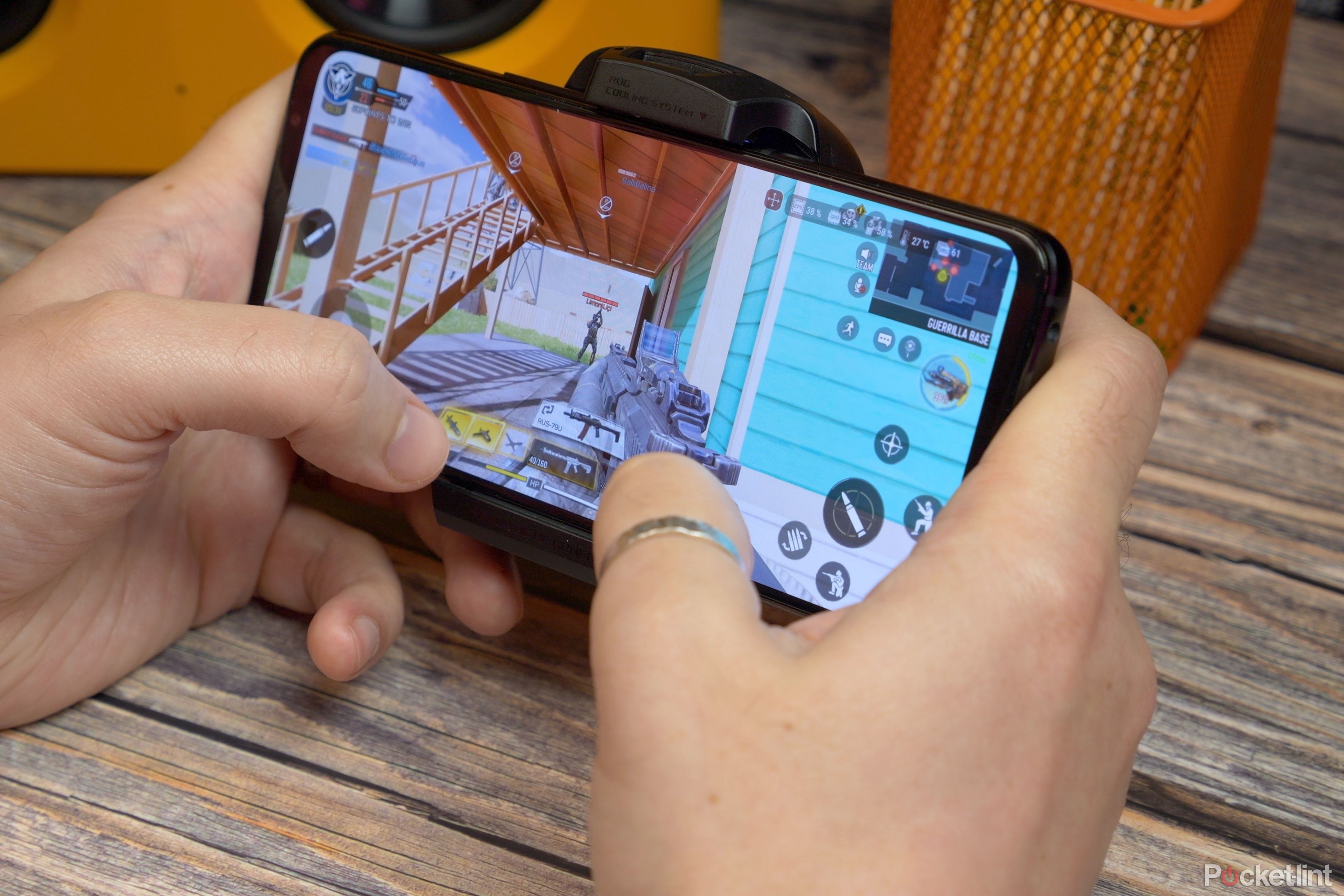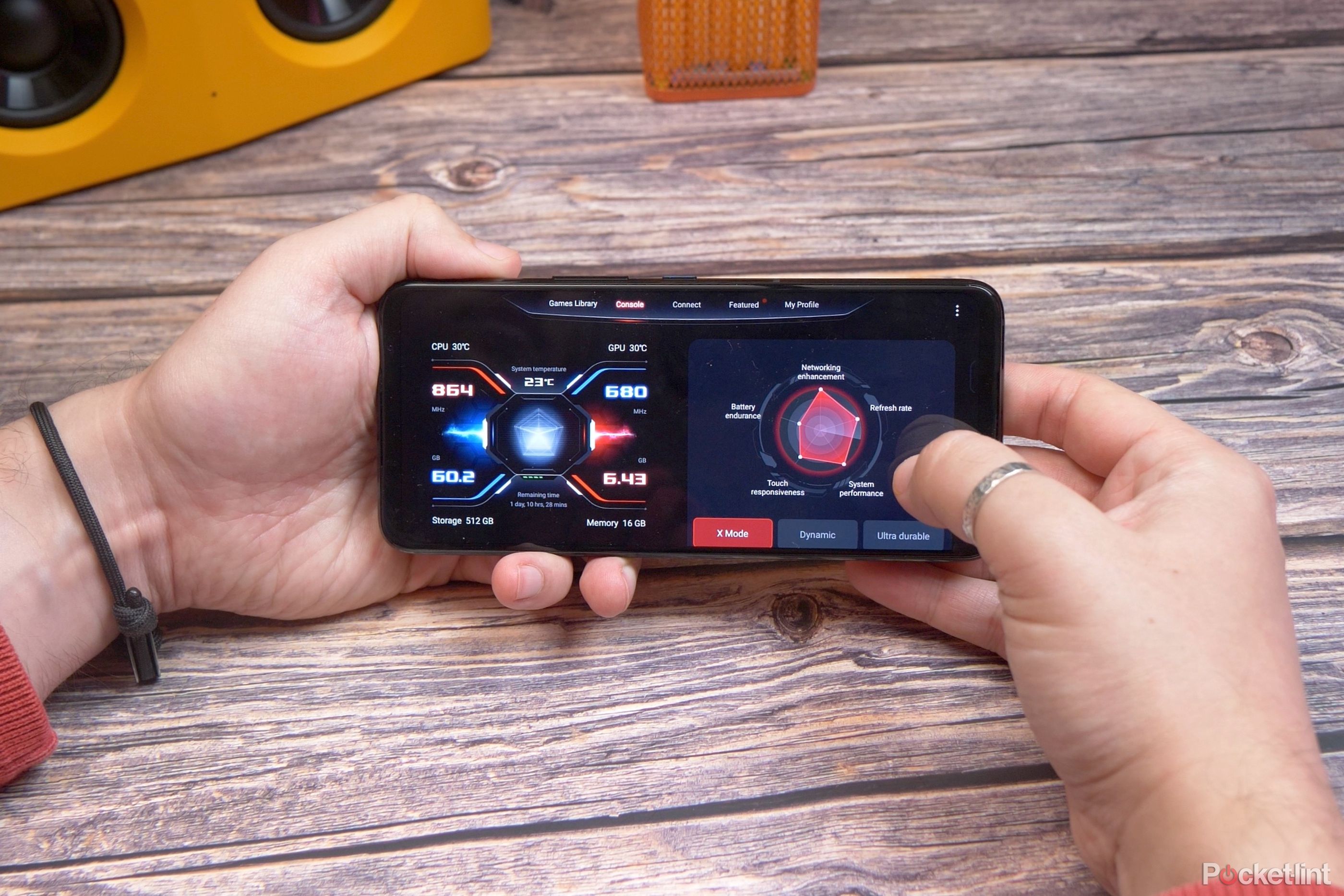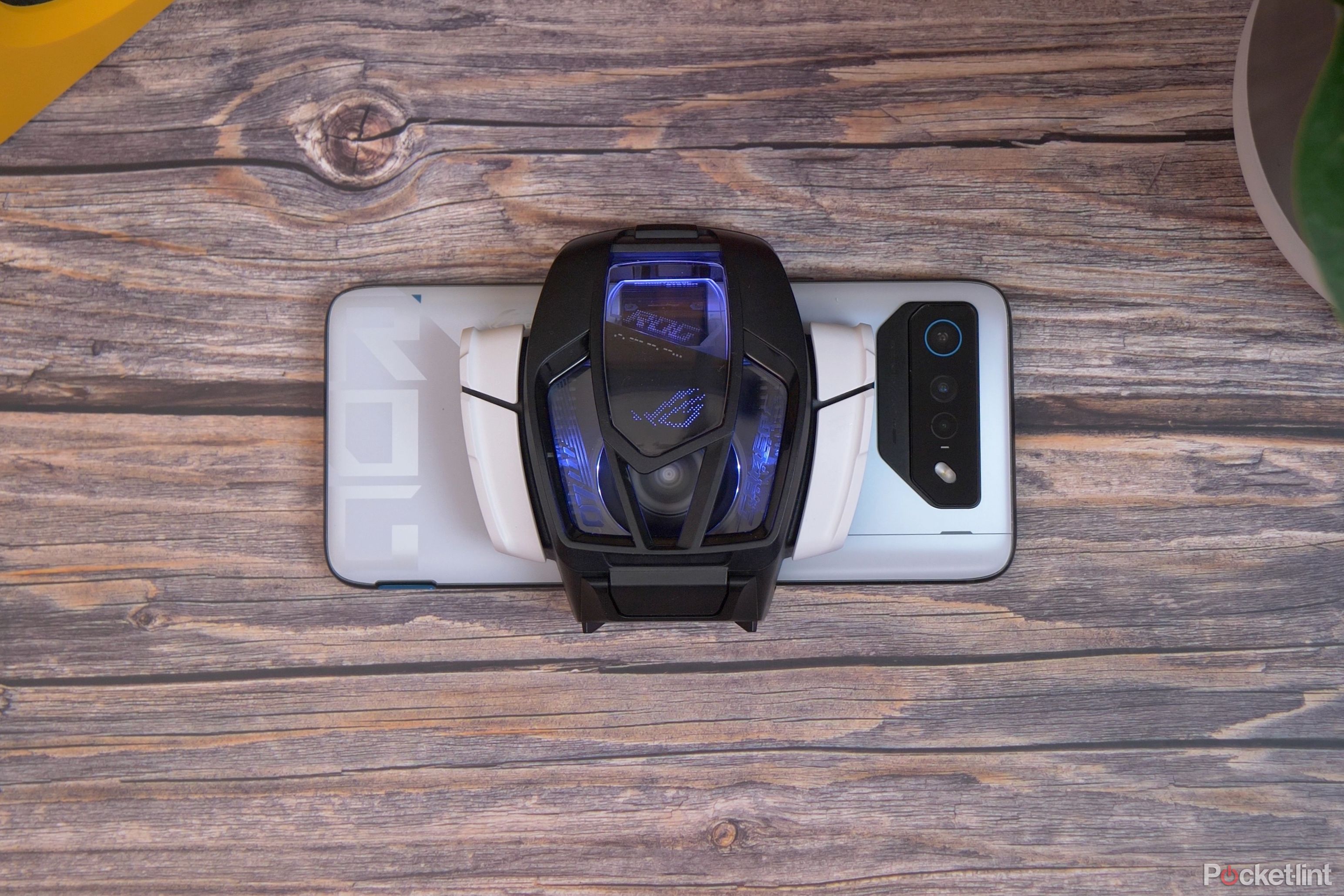For the past few years, Asus has been going all out to dominate the - admittedly niche - gaming phone market. Where competitors have tried to gain a foothold, the ROG Phone has become the gaming phone of choice.
The latest edition in the range - named the ROG Phone 7 - comes in two versions: ROG Phone 7 and ROG Phone 7 Ultimate.
Both stick to the philosophy of offering a big, bright screen, loud stereo speakers and flat-out performance that won't leave your hands getting so hot they melt to the back of the phone. While marketed as a gaming phone, we also think it's a stunning media consumption device. Read on to found out why.
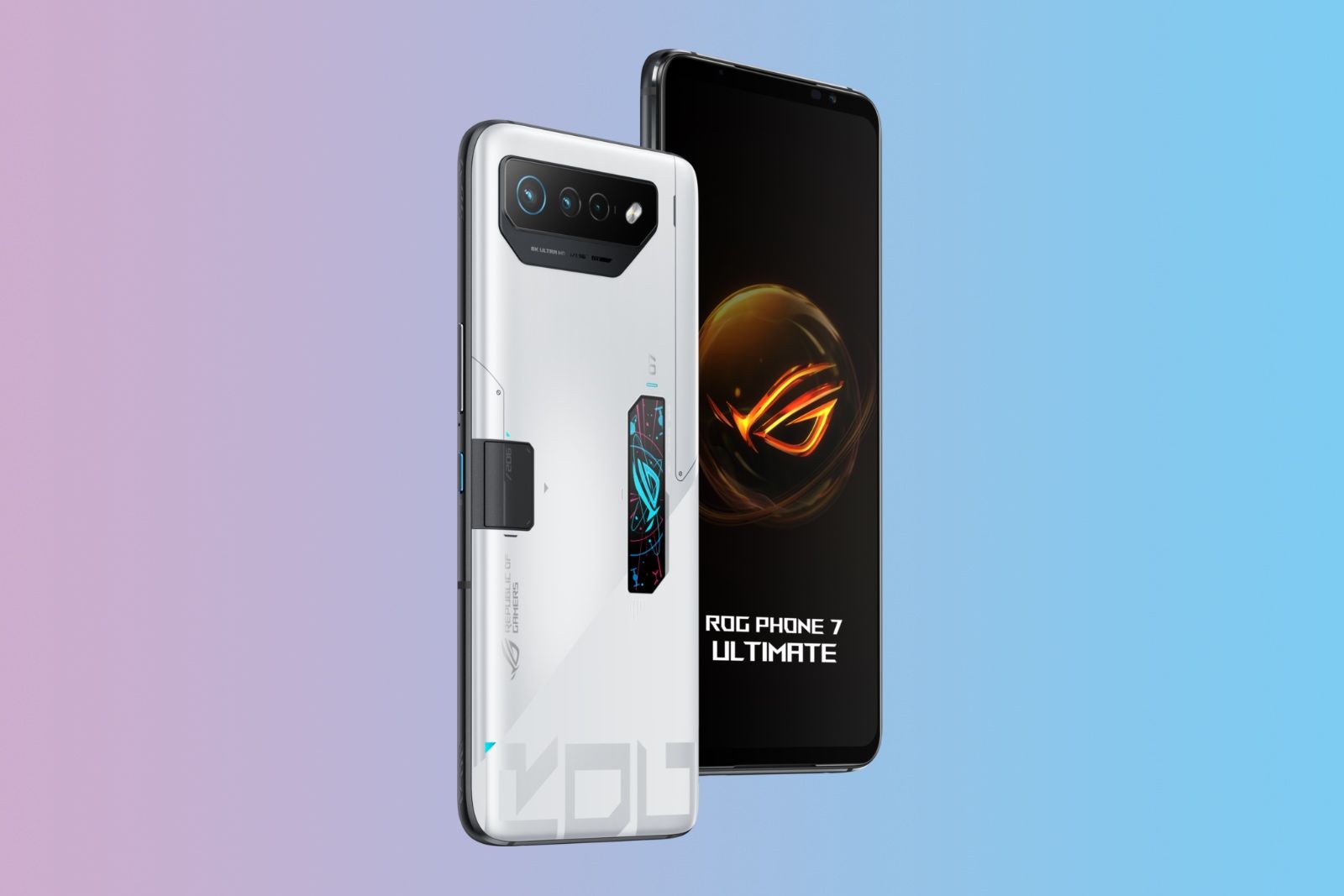
Asus ROG Phone 7
Asus ROG Phone 7 is the top gaming handset for 2023, delivering market-leading performance, excellent gaming software and reliable, all-day speed and battery life.
- Fast, consistent performance for long periods
- Big, bright and colourful display
- The best smartphone speakers around
- Long battery life
- It's big and bulky
- Pretty expensive
- Second and third cameras aren't great
Design
- 173 x 77 x 10.3mm - 239 grams
- Gorilla Glass Victus front - aluminium frame - glass back - IP54 water/dust resistant
- Storm White or Phantom Black colours
For its 2023 gaming phone range, Asus' ROG team created two versions: the ROG Phone 7 and ROG Phone 7 Ultimate edition. Both are largely the same in all the ways that matter, but there are subtle differences.
The Ultimate model features the ROG Vision colour display on the back, which can animate and show moving, colourful text, images and icons. It can be customised for different scenarios, like when you plug the charger into the phone for refilling, or when you're gaming. It's also a notification alert and can show notification icons or flash up when you receive a phone call.
There's also an AeroActive portal on the Ultimate model. Like we saw in the ROG Phone 6D, this portal opens up when you attach the included cooler fan. It's a small pop-up door mechanism near the edge of the phone, and it's designed to allow the cooler fan accessory to blow cold air inside the phone, helping it stay even cooler.
It is worth noting here - for those worried about longevity - the portal itself should last the lifetime of the device. It's been tested to 40,000 open/shut cycles. To put that into context, that's 27 times a day for four years. And remember, this only opens when you clip on the AeroActive Cooler fan, so it's not something you'll be constantly opening and shutting. Plus, like the rest of the device, it's IPX4 splash resistant, even when open.
The non-Ultimate doesn't have either of these features, instead offering a colourful RGB ROG logo that flashes and pulses, changing colour based on preset 'moods'.
Otherwise, the ROG Phone 7 is exactly what you'd expect it to be: big, chunky and pretty heavy. It's the kind of compromise you have to make to get the features and performance. It's a real handful. It's comfortably taller and thicker than either the Galaxy S23 Ultra or the iPhone 14 Pro Max, both of which are their respective companies' largest smartphone slabs.
Despite the size, Asus has made great use of the space, adding another USB-C port on the left edge for charging and accessory connection. The other edge features the ultrasonic touch-sensitive AirTrigger buttons on the shoulders and has kept the 3.5mm port on the bottom edge for wiring in headphones for truly lag-free, high-fidelity audio. Internals, media and performance have also been considered in the design of the phone too, but we'll speak more on that later.
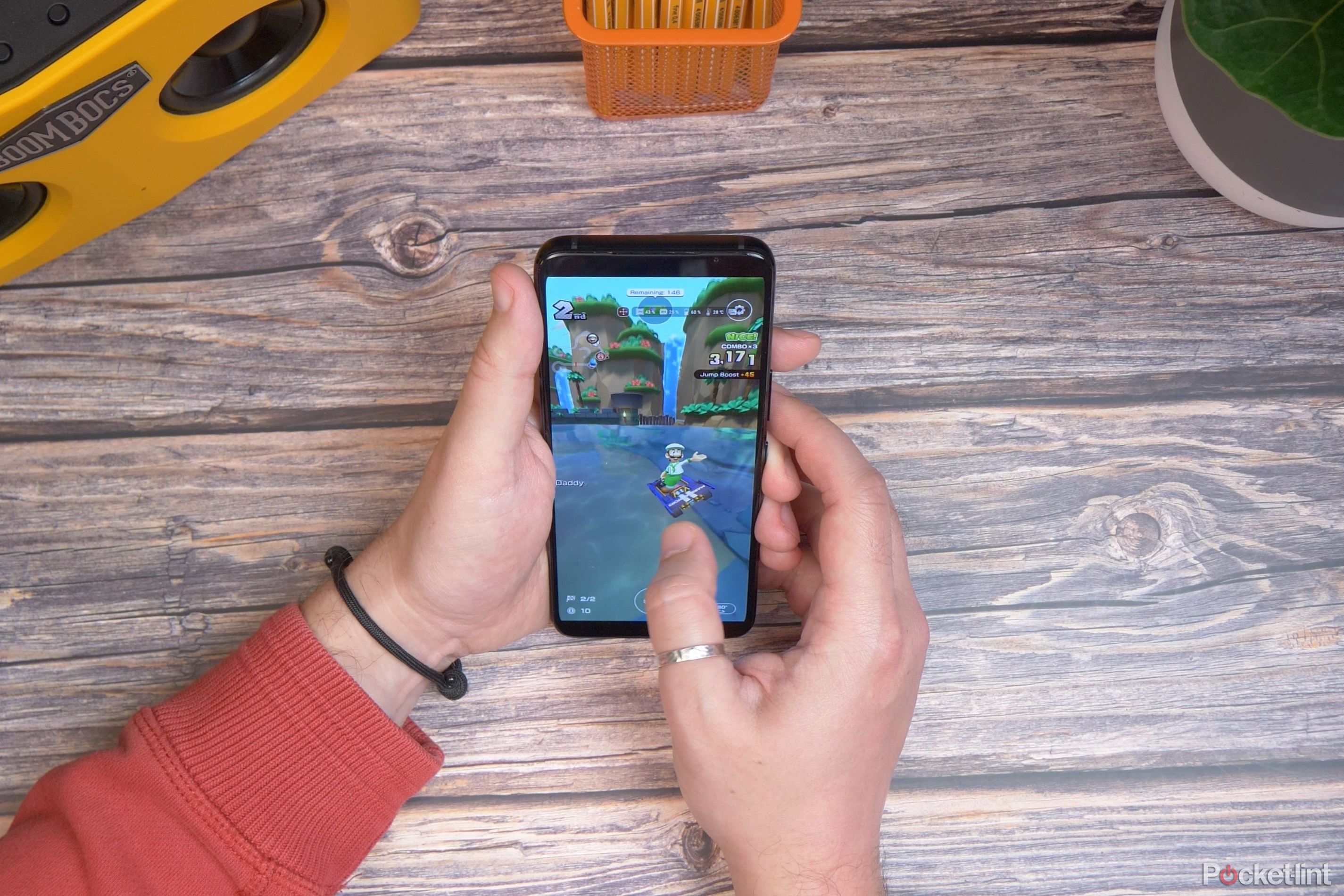
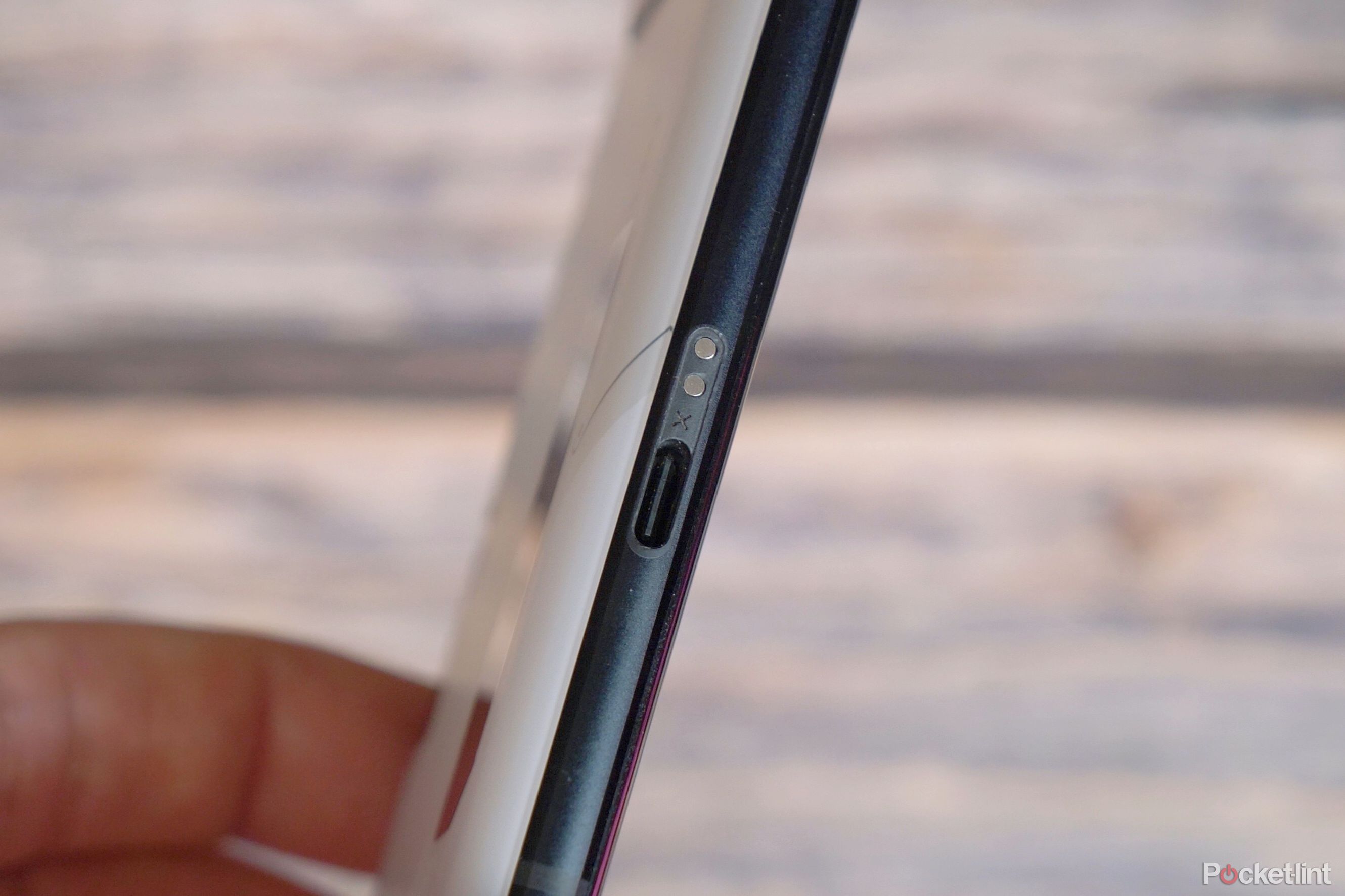
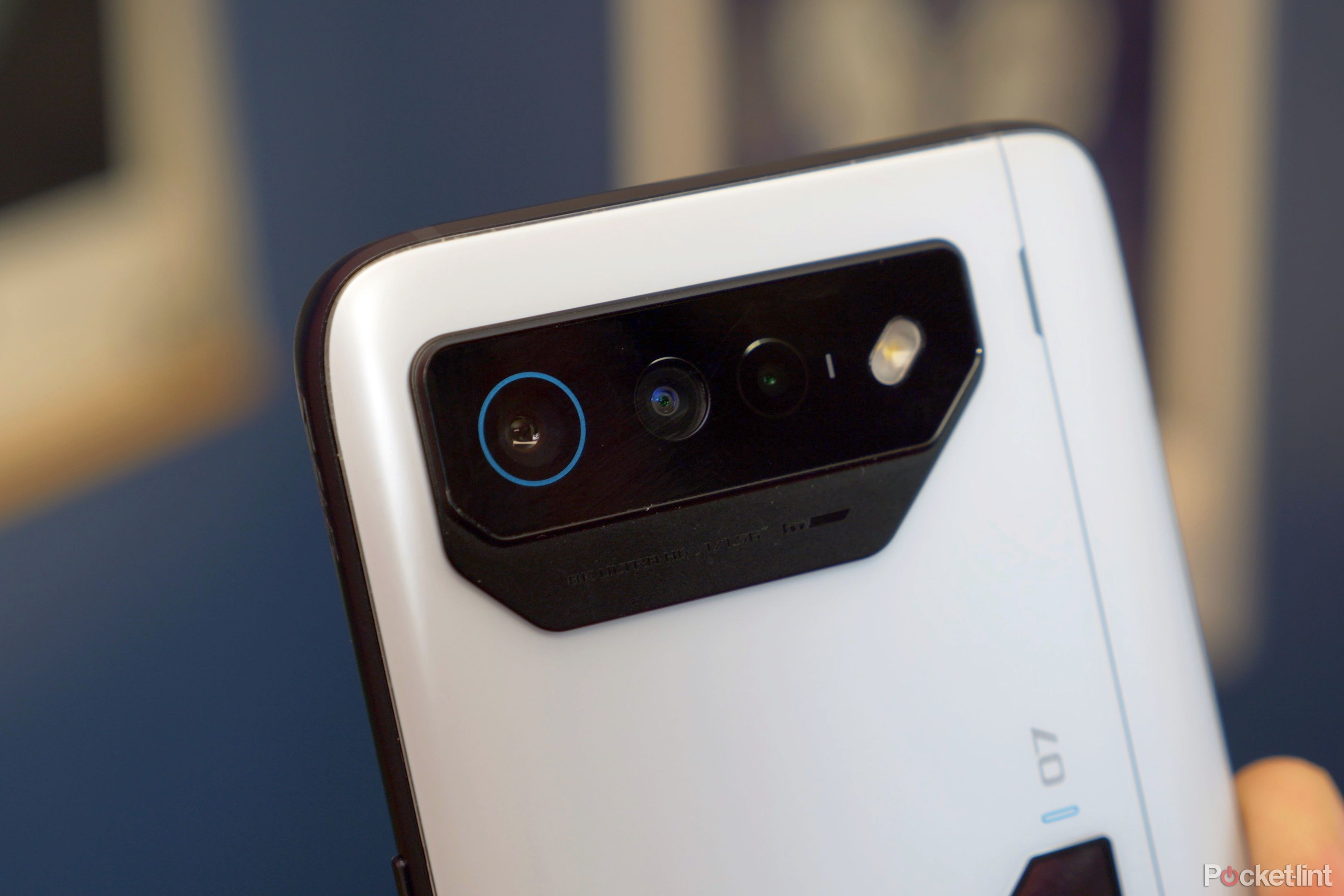
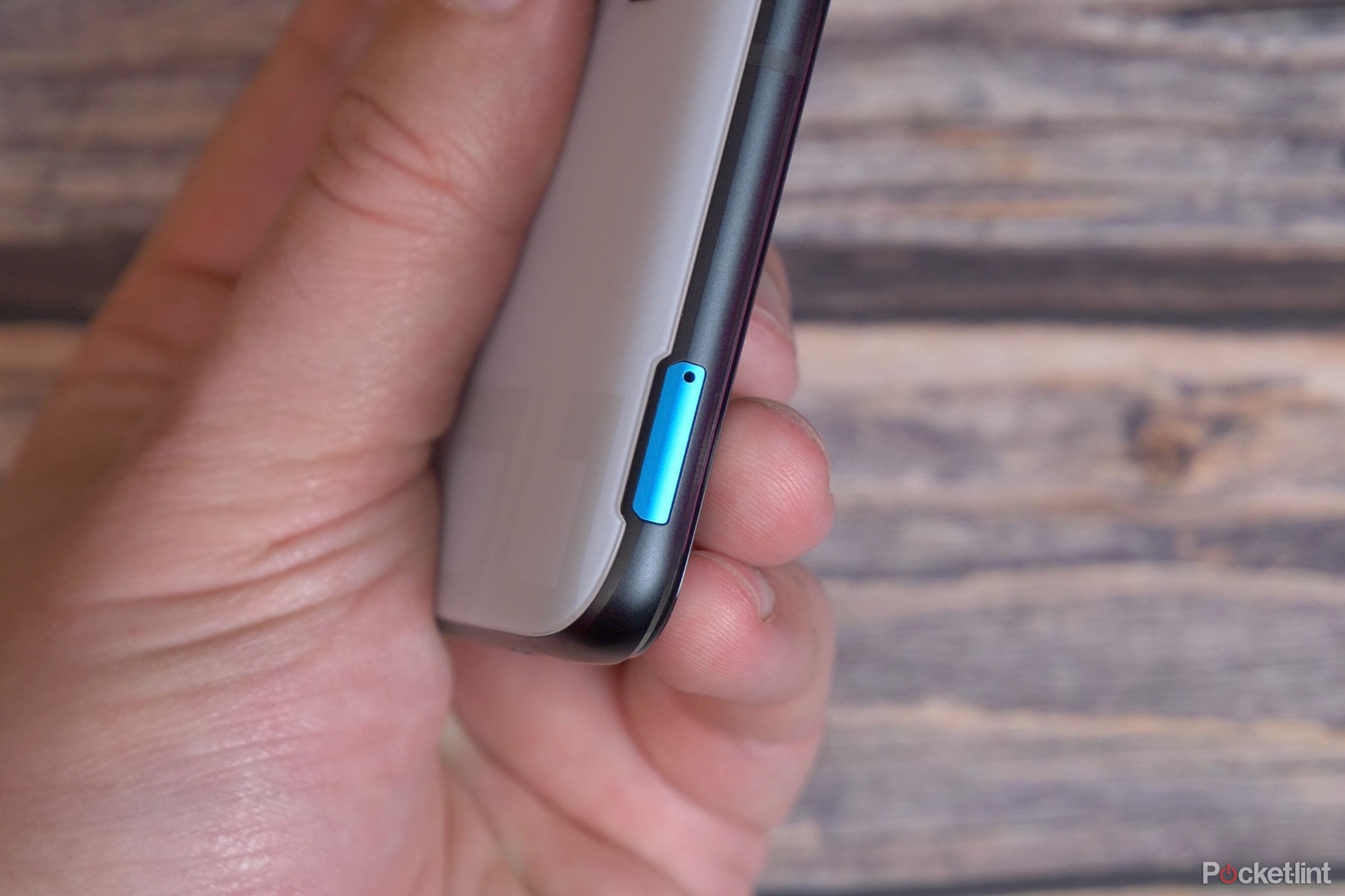
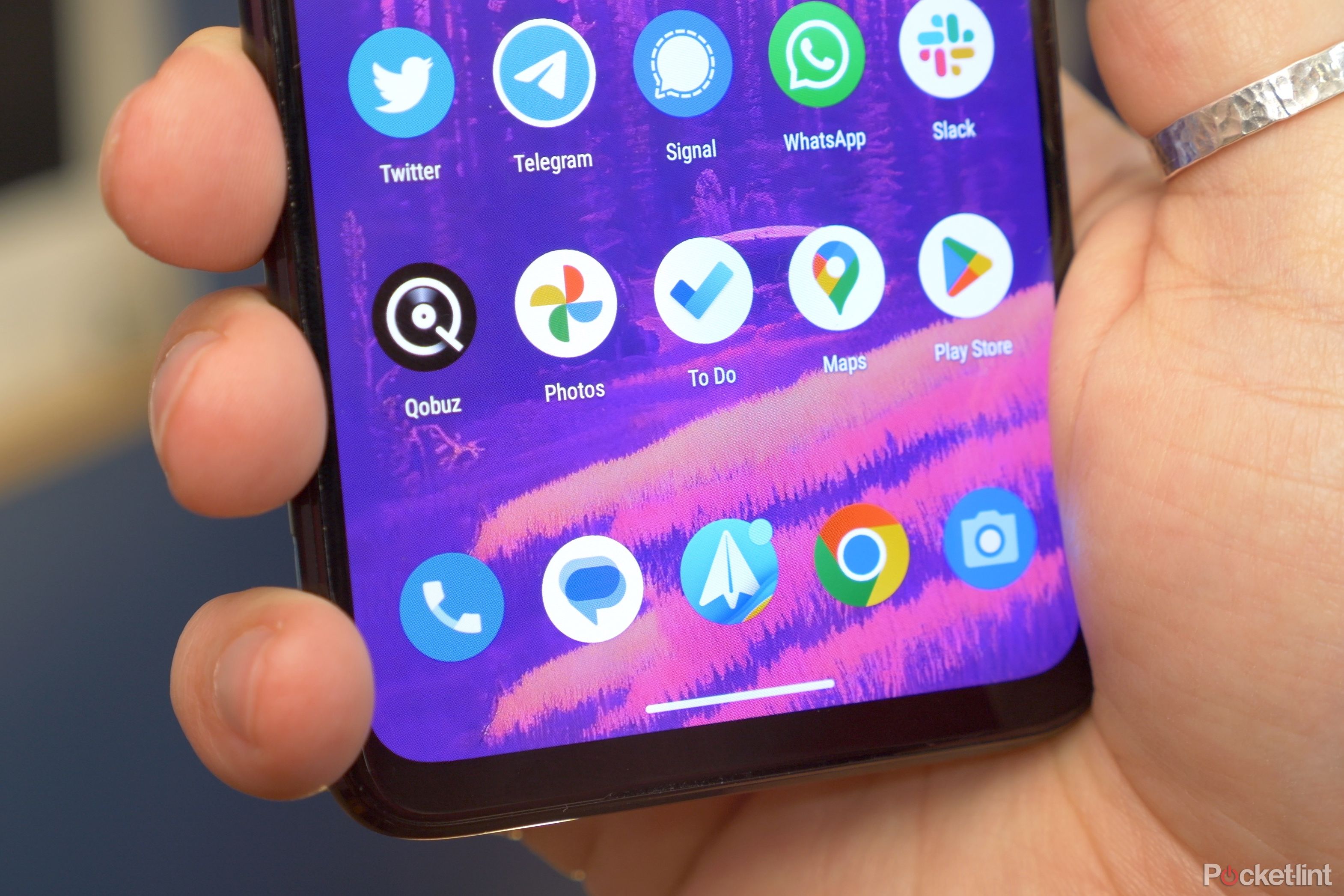
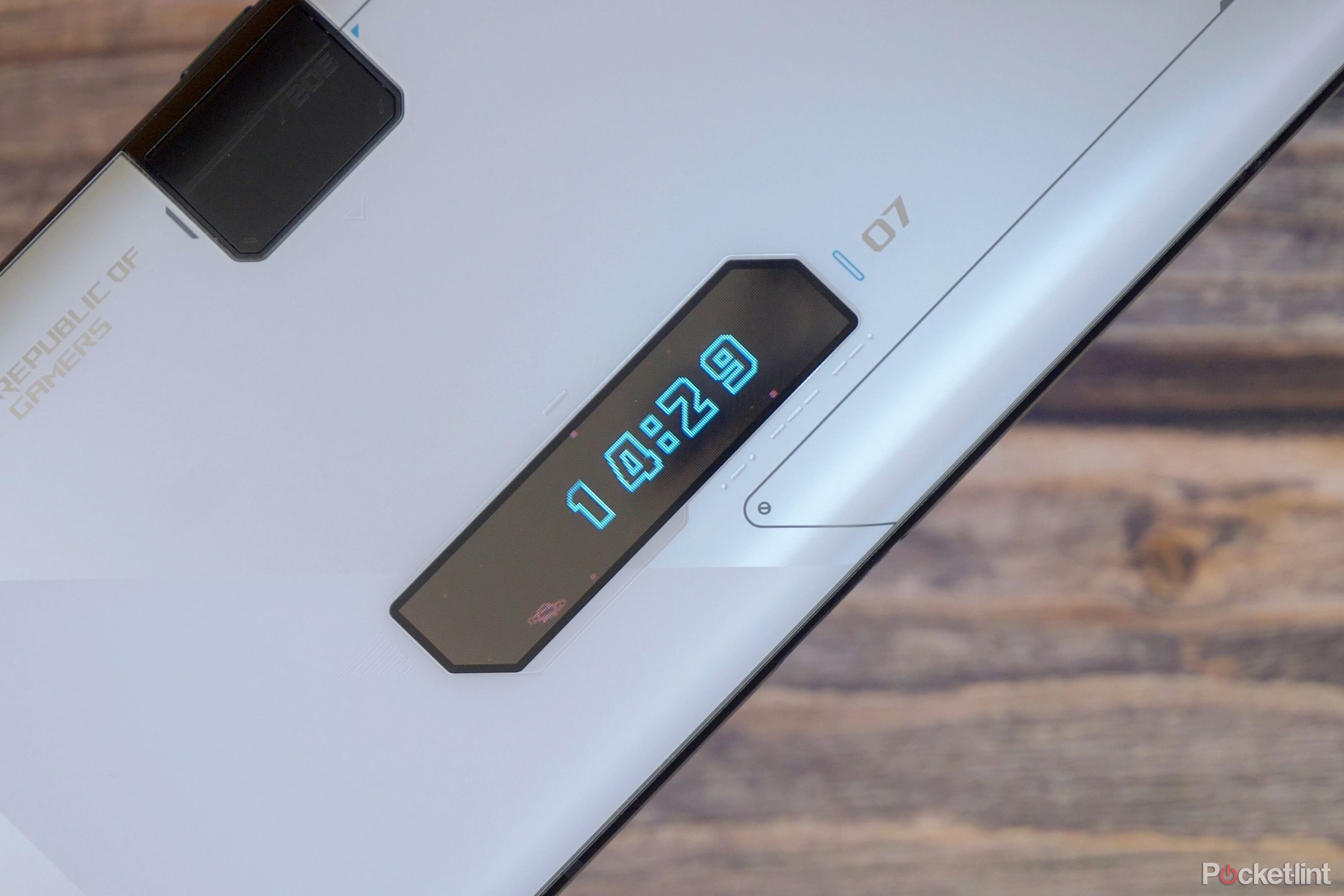
The front of the phone is almost completely flat, making it a great surface for typing on with two thumbs and also - crucially - ensuring your thumbs won't slide off during gaming. As is typical for a ROG gaming phone the bezel is slightly thicker on the top and bottom of the display, where the framing down the side is extremely thin.
It's not a bad thing necessarily, because it means Asus has been able to pack in extra capabilities, like the loud, powerful stereo speakers. It does date the phone though, and means it doesn't look as modern as the likes of the Samsung Galaxy S23 range with its extremely thin, uniform bezels. It also means you've got a bit of room to rest your thumbs.
As big as it is, the phone isn't horrendously uncomfortable to hold, at least not with two hands. The curves on the rear glass help alleviate the heft somewhat, and the one-handed mode built into the software means - like the Pixel 7 - you can swipe down near the bottom edge to bring the hard-to-reach stuff down from the top half of the screen when you need to.
Another area it lacks a little compared to more traditional flagships is in water and dust resistance. Its IP54 rating means it's only certified for splash/rain resistance, and isn't as protected against submersion as most phones from the likes of Samsung, Apple or Google.
Display and sound
- 6.78-inch AMOLED display - 2448 x 2080 resolution - 395ppi
- HDR10+ support - 165Hz refresh - 720Hz touch sampling - 1ms response time
- 1000 nits typical brightness - 1500 nits peak brightness
- 12x16mm super linear stereo front-firing speakers - Dirac HD sound
While ROG Phone has historically always been marketed as a gaming-first phone, much of what makes it great for gaming also makes it a great device for media consumption. It has a big, bright display that's flanked by two powerful, individually amplified speakers.
Not that it needed it, but Asus saw fit to upgrade the speakers for 2023's model. Each speaker is a 12 x 16mm driver and features a small excursion in the space designed to further amplify and direct the airflow for fuller sound. Plus, they're louder than the ROG Phone 6's speakers too.
What all of this means is that - yet again - the speakers deliver sensational sound. You get great stereo separation when playing games or movie watching in landscape mode. They're loud, yes, but what matters more is the balance of the frequencies. You get much more of the bass and mid frequencies than you would on a typical smartphone, which means a much more balanced sound. It's a phone that's actually good to listen to.
You'll hear elements in backing tracks - even in your casual games - that you've not heard before; if you've never used a phone with big, loud stereo speakers that is. There is a bit of an added kicker this year too, in form of the AeroActive Cooler 7 fan that comes in the box with the Ultimate model. It might be designed primarily as a cooling fan to keep your phone from overheating under extreme load, but this year, it also becomes part of the speaker system.
Asus describes it as a 2.1 portable theatre, adding a 5-magnet linear 13x38mm subwoofer to your phone, so you get even better bass performance in combination with the stereo speakers on the phone itself. It really does add a bass and volume boost to the audio too, delivering an even more powerful system for listening to music. And - since the cooler has a built-in stand - you can set it down on the side, and use the phone like a dedicated speaker. It's not quite as full-sounding as a quality dedicated portable speaker might be, but it's a darn-sight more capable than pretty much any other phone.
Add to that the near-enough 7-inch display (technically 6.78-inches), and you have a very capable media delivery tool.
That display itself is a very strong performer too. There are some areas it falls a little short compared to the S23 Ultras and Xiaomi 13 Pros of the world, but it more than makes up for it in other ways.
That's to say that it isn't QuadHD resolution (or any variation of), instead, it's full HD+ which - on a screen this size - is still more than sharp enough. You don't get the ultra-crisp details in fine lines and curves, but it's still nearly 400 pixels-per-inch, so it's sharp enough that you can't see individual pixels easily at all.
Its best properties are its brightness, refresh rates and touch response. With a typical brightness of 1000 nits, it's incredibly bright in most situations. It even copes well in daylight, and can still be easily seen when surrounded by bright light. When needed - for bright peaks in HDR content - it can reach up to 1500 nits.
It's an absolutely superb display. Colours are rich and - when combined with the excellent dynamic range - it gives full impact to shows with high-quality cinematic video. Shows like Our Planet on Netflix, with its stunning nature cinematography look incredible on the ROG Phone 7's display. Being critical we could say the contrast is push a bit too high at times, but it rarely crushes details, even when the dark spots are really, really dark.
Being a gaming phone also means quick refresh rates come as standard. It's capable of up to 165Hz when required, with the ability to automatically switch between 60Hz, 90Hz, 120Hz, 144Hz or 165Hz, depending on what's on the screen. Combined with the 720hz touch-sampling (that's the speed at which it can detect your finger moving across the touchscreen), it makes for very responsive and fluid animations in the interface.
Performance, thermals and battery
- Snapdragon 8 Gen 2 chipset - 16GB LPDR5X RAM - 512GB UFS 4.0 storage
- Dual 3000mAh batteries (6000mAh total) - 65W wired charging - 45 minute total refill
- Wi-Fi 6 and Wi-Fi 6E aboard - Bluetooth 5.3
We mentioned at the beginning that part of the phone's design is down to internal considerations, and that's completely true. Like its predecessor, the ROG Phone 7 has an unconventional internal build, in that the main CPU/chipset sits in the middle of the phone on the back and is flanked - in landscape - by two halves of the battery.
The idea being that when held in landscape, your fingers don't come into contact with that centre point which is also the hottest spot on the phone. It's also designed this way to manage thermals more effectively, and thermal management is a big focus on the new ROG Phone.
There are several layers of cooling and a few different elements and components that combine to effectively reduce the temperature of the processor, in order for it to run at high power for a long period of time without the phone overheating. Asus has combined large graphite sheets, an efficient thermal paste and a redesigned vapour chamber, featuring new channels and microscopic wicks that increase the internal liquid flow rate and improve cooling on the last model. All of this ensures the phone can make the most of its speedy, powerful hardware.
It starts - of course - with the Snapdragon 8 Gen 2 processor, which - at time of writing - is the most powerful Qualcomm smartphone chipset on the market for Android phones. It's joined by 16GB RAM and 512GB storage, and not just any storage and memory. This is the latest LPDDR5X RAM and UFS 4.0 storage, which means a 33 per cent increase in memory performance and somewhere between 2x and 3x speed increase in read/write speeds on the storage. In short: it's fast.
For the spec-conscious, it's worth pointing to the fact that Samsung's Galaxy S23 Ultra has the same processor, but clocked to a higher speed on the main core. ROG Phone 7's chipset is clocked to 3.2GHz whereas Samsung's is 3.36GHz. That - of course - doesn't tell the whole performance story, especially given ROG Phone 7's cooling system.
The end result is - unsurprisingly - a phone that feels fast and responsive regardless of what you're doing with it. And it can cope with long gaming sessions. In fact, that's doing it a bit of a disservice. It absolutely flies through long gaming sessions. Even without the cooling fan attachment clipped on the back it can keep frame rates consistently stable at 60fps in Call of Duty even after half an hour, with the internal temperature barely reaching above 40 degrees Celsius. With the AeroActive cooler clipped on, that can drop to below 30 degrees. In short: it can keep up with the most demanding titles, and does so without overheating or feeling excessively warm on the back.
Because of the touch response rate, combined with the power and cooling, touchscreen interactions in games are immediately met with the appropriate action. At times, it can feel a bit too responsive, but once you get used to that, the speed can really help in games where reaction times matter.
The battery life is rarely troubled either. With a 6000mAh battery - split in two 3000mAh halves - the ROG Phone 7 has enough to keep up with even the most demanding of users. Our own typical usage, which is quite moderate, meant it wasn't too difficult to get it to last two work days on a full charge. That's with using the phone about 2-3 hours a day split between some casual gaming, web browsing, Twitter and YouTube usage.
To drain it in one full work day you'd have to put some serious time into it, and even if you do, you're not likely to ever experience battery anxiety. It ships with a 65W fast charger and can deliver a full charge in under 45 minutes. And - because it's Power Delivery compatible, you can use pretty much any USB-C cable and get the same speeds. You don't need to use the braided cable that ships with the phone if you don't want to.
Gaming and software
- Android 13-based ROG UI & Zen UI
- 2 major OS updates - 4 years of security patches
To be a good gaming phone, good gaming-optimised software is required, and Asus has this down to a tee. It has a couple of tools here: one called Armoury Crate which acts as a one-stop hub for gaming-related elements, and then Game Genie. You can swipe this in as an overlay during your gaming sessions to toggle various settings, like blocking calls and notifications or showing your phone performance stats on screen. If you're playing intensive games and want to see your phone's internal temperature or the frame-rate in real time, you can enable that and have it floating on the display too.
Armoury Crate is a lot of things in one. On the one hand, it's a good place to go to launch straight into games, and offers you a view of all your games so you can swipe through and customise phone settings for them. That means if you want to have the absolute best performance possible on a particular title you can - essentially - tweak performance settings to ensure that you're getting the fastest, smoothest experience possible in that game.
You can also use Armoury Crate to customise the ROG Vision or the RGB logo on the back of the phone, telling it what to do in different scenarios. In the 'Console' tab you can look at and customise various other settings, mostly around performance. And - if you have the AeroActive Cooler 7 fan clipped on, you can adjust settings for that too. It'll let you switch between four different cooling modes, depending on how much cooling you think you'll need and adjust settings for the touch-sensitive AirTriggers on the side of the phone.
One of the advantages of AirTriggers - and the physical buttons on the AeroActive Cooler - is that you can map them to specific sections of the display, so that you're not constantly trying to use fiddly onscreen controls. We've long found them useful for games with lots of buttons and controls on the screen, because it means you keep your fingers from blocking the view all the time. In games like Call of Duty it's a godsend having physical buttons mapped to aiming and shooting, reloading and coaching. Anything that keeps as full a view of the screen as possible is a good thing.
Cameras
- 50MP IMX766 main camera sensor
- 13MP ultrawide camera - 8MP macro
- 8K video recording at 24fps - 4K up to 60fps
It wouldn't be a modern phone without multiple camera lenses on the back. In this instance, it's three lenses and - arguably - only one of this is what we'd describe as a good. That, of course, is the primary camera which features a 50-megapixel Sony IMX766 sensor. A sensor which has been used in a few different flagship smartphones over the past couple of years and one which - along with the Snapdragon chip's image processing abilities and algorithms - can produce good shots in most conditions.
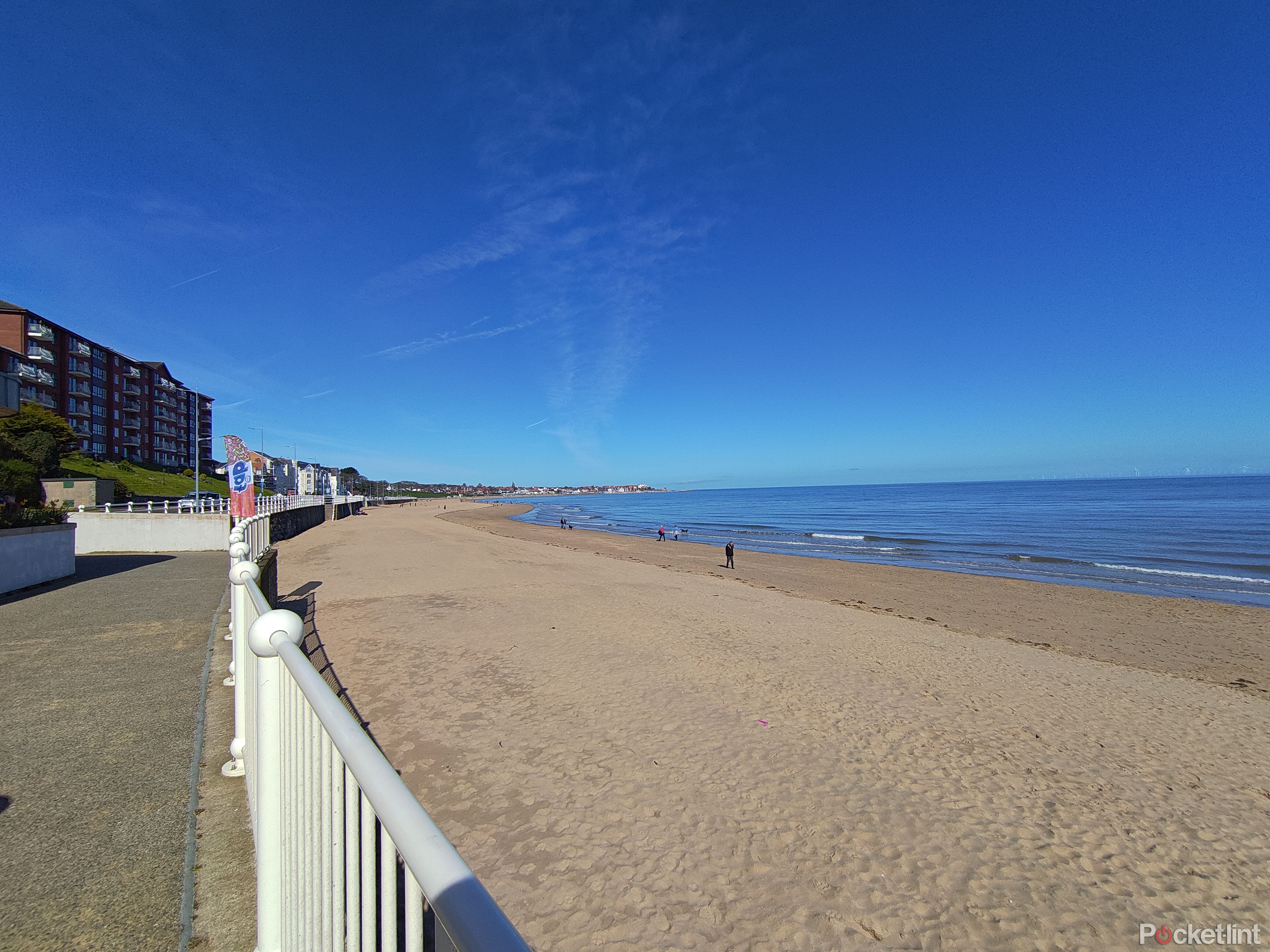


Images in daylight are vibrant, colourful, contrast-rich and detailed. There's an argument to be had about how saturated you want colours to be, and how much contrast is a good level, but the photos that came from this main camera do look good. Even with less ideal situations it doesn't struggle too much.
The other two lenses, sadly, aren't as capable. The 13-megapixel ultrawide offers that extreme wide angle field of view, but is noticeably poorer than the main camera in terms of overall image fidelity. Details aren't as crisp, and even in bright sunshine it creates noise and graininess, particularly in blue skies and shadows.
The third lens is a macro camera and lets you get really close to objects to take a photo. It can be tricky to get an in-focus shot a lot of the time sadly, and like the ultrawide, its results aren't as good as the primary camera. Pictures are a bit harsher, and it struggles to balance out highlights and shadows.

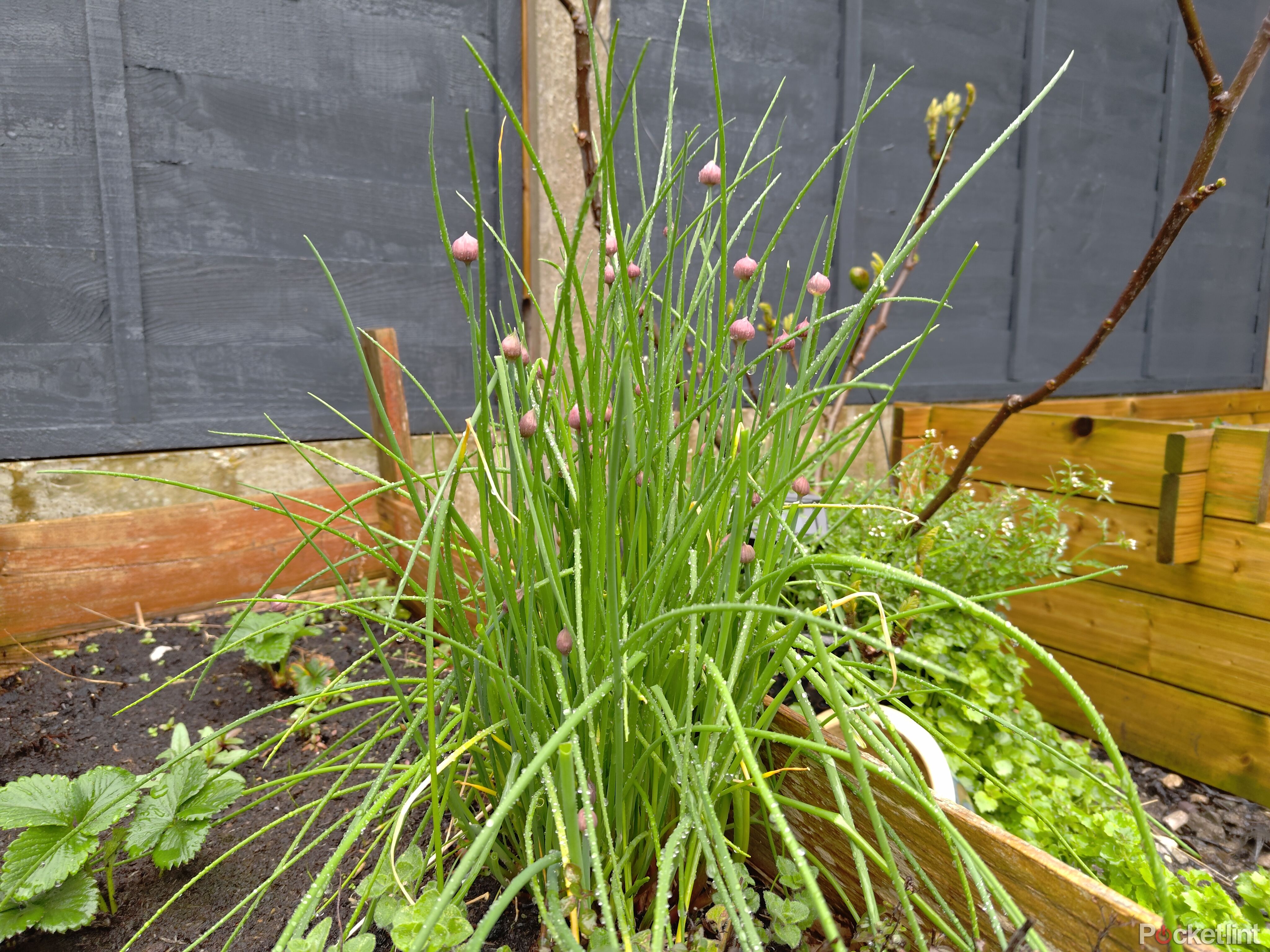
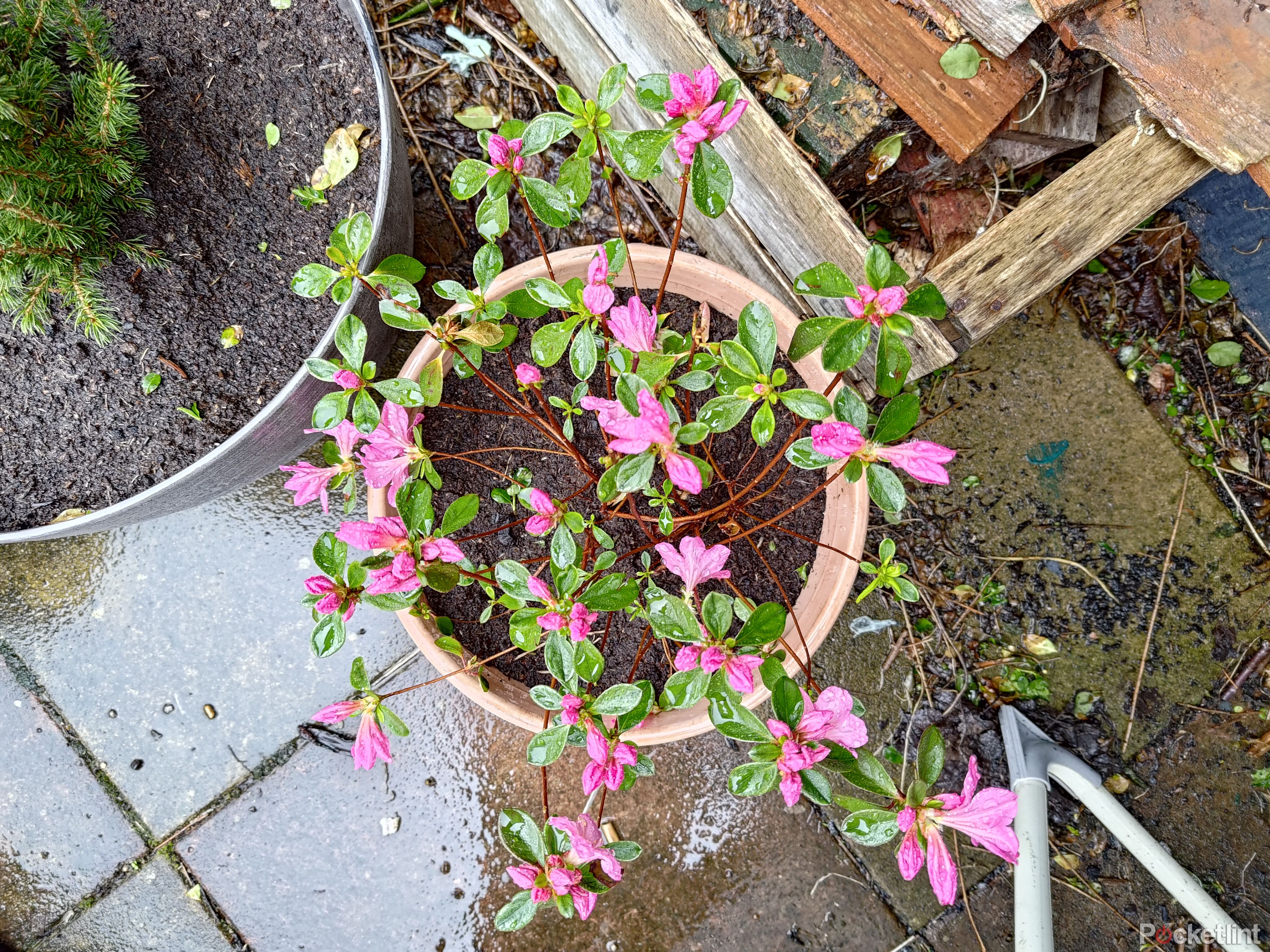


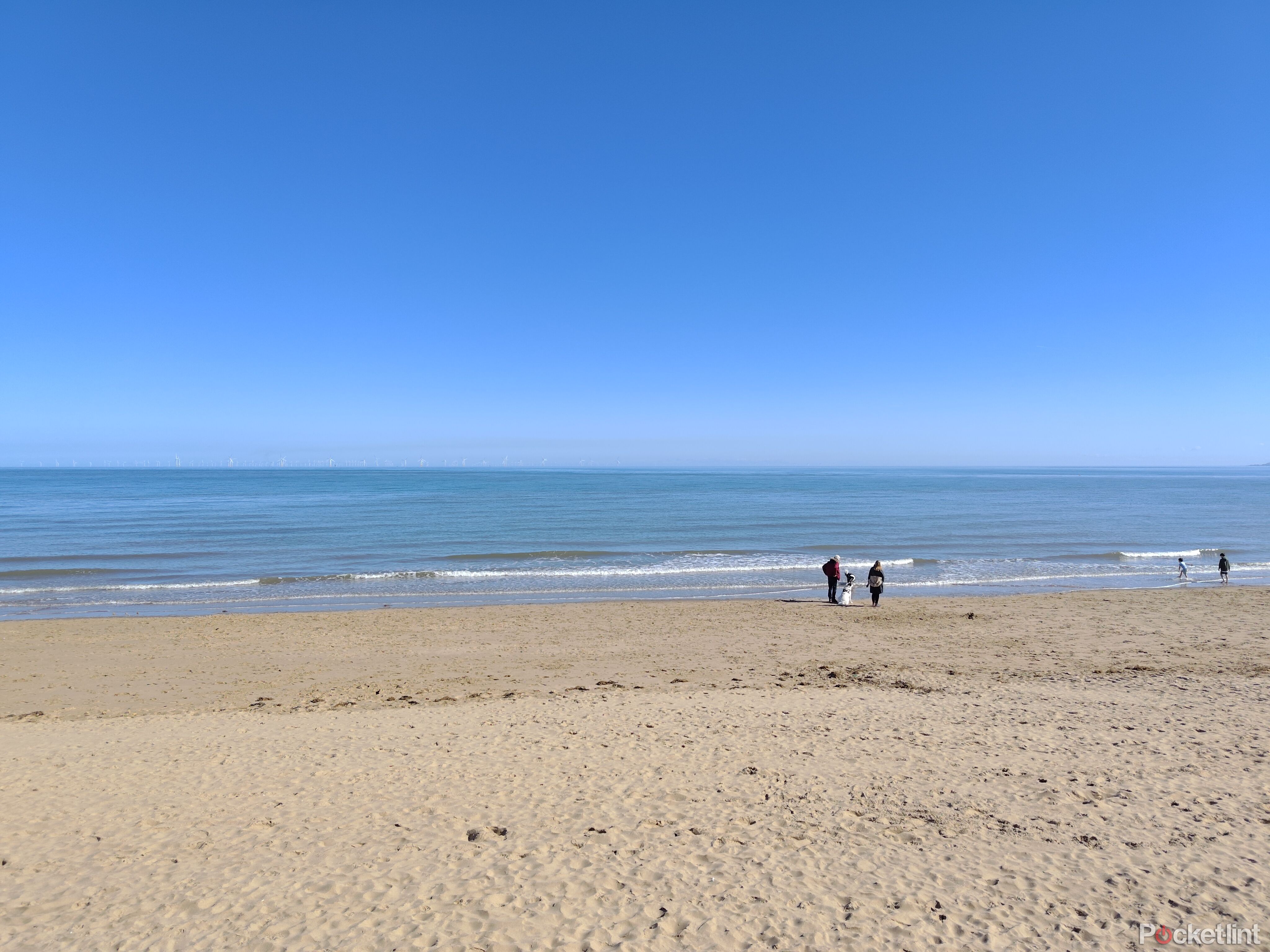
This is a gaming phone of course, so cameras aren't a primary concern. Still, with the quality of the main camera, you'll be able to snap good shots and there are plenty of creative tools to use in the app to make it a fully-featured system. It's got fun light-painting/long exposure modes, night mode, and pro/manual modes for both still photography and videography. So even those don't want to rely on the phone's automatic exposure, shutter and aperture control are catered for.
If you are in the market for a great camera phone, however, the ROG Phone 7 isn't one we'd suggest is as good as the top models. The likes of the S23 Ultra, Pixel 7 Pro and iPhone 14 Pro all have much more capable systems with multiple lenses and focal lengths which have stronger all-round performance. Rather than have one strong camera, all cameras on those models are strong.
Verdict
Asus' reign as the best gaming phone maker isn't about to end anytime soon. Like a lot of phones in 2023, the improvements are quite incremental on the 6 Pro, but there's so much performance here for those who really care about getting the most from their intensive games.
When you add that to a fantastic display, the best stereo speakers on any phone, a big battery and one decent camera, and you have a great all-round media consumption device.
There are compromises with this phone. Beyond the usual expensive price point, there's the fact that it's a huge, heavy phone and the supporting ultrawide and macro cameras aren't great even if the primary snapper is actually decent this year.
Still, as long as having a small, compact phone or having the best cameras isn't at the top of your list, it does so much really well. It's probably our favourite phone for watching movies and TV shows on and will remain that way until another manufacturer manages to up their loudspeaker game. It's a brilliant all-round phone, even if it's not for everyone.


